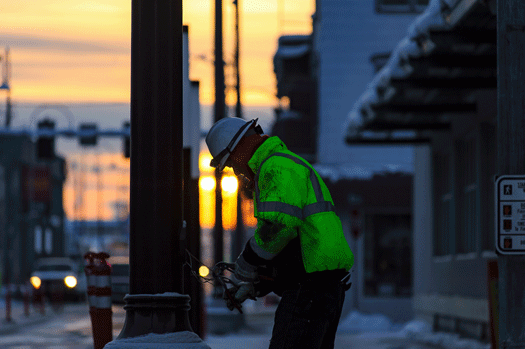We use cookies to make your experience better. To comply with the new e-Privacy directive, we need to ask for your consent to set the cookies. Learn more.
Winter Outdoor Work: Safety Tips for Electrical Contractors
Electrical contractors can’t take the whole winter off. However, cold weather can create all sorts of safety problems for electricians — especially those who work outdoors, or in unfinished construction projects that lack heat.

Winter weather is more than just a comfort issue. There are serious safety concerns associated with working in the ice and snow, as well. Here are a few ways electricians can stay safe while getting the job done all winter long:
Dress for the weather.
That means layers. According to the Occupational Safety and Health Administration (OSHA), outdoor workers should “wear at least three layers of loose-fitting clothing.” These include:
- Wicking undergarments. Wool, silk, or polypropylene long underwear will do the trick.
- Above the base layer, wear more wicking materials. Wool or synthetics that continue to hold in heat, wet or dry are ideal.
- Finally, the outer layer should be designed to block the wind. A bit of ventilation will help, too; it’s remarkable how quickly you can overheat, even in freezing conditions, with all those warm layers on.
- Boots should be insulated and waterproof.
- Finish the outfit with a warm hat that covers the ears, insulated, waterproof gloves, and a scarf of knit mask for the face.
Layered dress has many advantages. The air between layers acts as additional insulation, sealing in body heat. If the heat gets too intense, it’s easy to shed a single layer, giving you greater control over temperature throughout the working day.
Prepare for the ice and snow.
According to the Bureau of Labor Statistics, workplace fatalities caused by falls, slips, and trips are on the rise. Since 2011, the number of fatal falls at work increased by 25 percent. During winter, ice and snow create particularly dangerous conditions for outdoor workers like some electricians.
Linemen and cablemen must be particularly careful, given their frequent work at height. The key to controlling winter workplace hazards is extensive preparation. That should include things like:
- Consistent snow removal.
- Providing plenty of winter supplies, like shovels, rock salt, and ice-melt.
- Don’t forget the “Wet Floor” signs at entrances, where snow falls from boot tread and quickly melts into puddles.
- Store these supplies where workers can’t help but notice them. Keep bags of ice-melt at all doorways, docks, and stairs, and train staff to de-ice frequently.
It’s important to remember that snow and ice aren’t just a problem on outdoor surfaces. They also lead to wet floors indoors. Be sure to provide absorbent mats inside all doorways, and keep mops handy for cleaning up bigger puddles.
Train employees to recognize symptoms of hypothermia and other types of cold stress disorders.
It’s all too easy for outdoor workers to suffer the results of cold stress, especially if they have weakened immune systems, high blood pressure, or conditions like diabetes. Electricians working in the cold should monitor one another for these common symptoms of hypothermia, as listed by OSHA:
- Uncontrollable shivering
- Confusion, loss of coordination, and/or slurred speech
- Slowed breathing and/or heartbeat
- Unconsciousness
In addition to hypothermia, employees should recognize the early symptoms of immersion foot, or trench foot, which occurs when feet are wet and cold for long periods of time. These symptoms include pain, itching, or tingling, as well as numbness, cramps, reddened skin, and blisters.
Loss of feeling in the extremities, blisters, tingling or pain, and discolored patches on fingers, earlobes, toes, or the nose could all be signs of frostbite. Employees must not ignore these symptoms, in themselves or their coworkers, and should be ready to seek medical help immediately.
With a bit of preparation, there’s no reason electrical crews can’t be just as safe and productive in winter weather as they are during the warmer months. As in so many cases, prevention and planning are the keys to success.
References:
Census of Fatal Occupational Injuries Summary, 2016. BLS. Bureau of Labor Statistics, U.S. Department of Labor, 19 Dec. 2017. Web. 11 Oct. 2018.
O’Connor, Tom. “Slips, Trips and Falls.” ECMag. Electrical Contractor Magazine, Jan. 2014. Web. 11 Oct. 2018.
O’Connor, Tom. “You’re Gonna Need a Bigger Coat.” ECMag. Electrical Contractor Magazine, Nov. 2015. Web. 11 Oct. 2018.
“Winter Weather. Plan. Equip. Train.” OSHA. Occupational Safety and Health Administration, U.S. Department of Labor, n.d. Web. 11 Oct. 2018.
